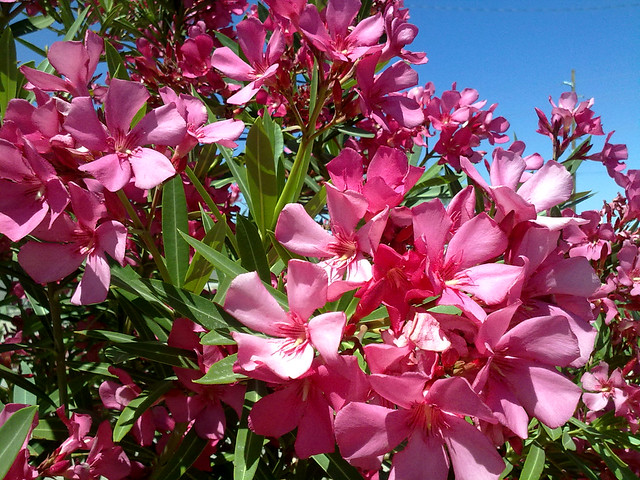Eating These Flowers Will Kill You Instantly
As an experienced florist, I have seen my share of beautiful flowers and plants. However some really stand out. Why? Some garden flowers are literally drop dead gorgeous. Yes, you might be surprised to learn some of the world’s most poisonous flowers are lurking right outside your window, “innocently” posing as ornamental plants and shrubs. While you aren’t likely to encounter any of these when you buy flowers, it’s important to know they do exist and how to recognize them. Eating these flowers, their berries, leaves, or roots can kill you. In fact, just touching these plants or their sap can lead to skin and eye irritation. I urge you to educate your family and friends about the dangers of poisonous plants and take care when pruning or cutting these potentially fatal flowers.
Daphne 
photo© Wendy Cutler
Daphne is a semi-evergreen shrub bearing clusters of small and fragrant rose, white, or purple flowers. It grows mostly in the southern United States. Daphnin and mezerine are the toxins present in this plant, with the highest concentrations occurring in the berries and sap. Ingesting this plant can cause convulsions, headaches, and in severe cases coma and death. It only takes a few berries to kill a child.
Deadly Nightshade 
photo© Donald MaCauley
The toxicity of belladonna has been known since the time of the Roman Empire when it was used by the ancient Romans to poison enemies. The flowers of this plant are small, reddish purple and tubular shaped, but it is the berries that are the most deadly part of the plant. The atropine found in belladonna disrupts the nervous system and can destroy the body’s ability to regulate breathing and heart rate, leading to death. I have to admit that belladonna is not all bad; the same poison that can kill, if used in the right amounts can be used to treat various diseases.
Angel’s Trumpet 
photo© Cliff
Don’t be fooled by the name of this plant—it is certainly no angel. Angel’s trumpet is a shrub or small tree bearing trumpet shaped pendulous blooms in many colors. I think it is striking as a potted patio tree. It contains scopolamine and atropine, two hallucinogens and poisons. The entire plant is poisonous with the highest concentration of toxins in the seeds. Hallucinations, coma, and delirium are side effects. Some Amazonian tribes use this plant as a hallucinogen in rituals, but overdose can be fatal.
Azaleas 
photo© Charles Bell
These evergreen ornamental shrubs are extremely popular in landscapes; in fact, I have some myself. They feature large, stunning round clusters of flowers in pink, orange, red, white, and lavender. The plant contains andromedotoxins which cause pain, nausea, paralysis and sometimes death. All parts of the plant are deadly. Even honey from this plant can be toxic—the Greeks called it “mad honey” after observing Greek soldiers that had eaten it.
Oleander 
photo© Hadley Paul Garland
Oleander is a large shrub or small tree that grows in the south, featuring clusters of pink, white, or red flowers with an alluringly sweet scent. Although this plant is well loved with entire societies devoted to it, it is one of the most poisonous plants in the world due to oleandrin and neriine. These two compounds affect the cardiovascular, digestive, and nervous systems simultaneously, leading to tremors, seizures, drowsiness, and death. The sap can cause eye and skin irritation.
Wolf’s Bane, or Monkshood 
photo© F.D. Richards
Wolf’s Bane is an appropriately named flower; it is the bane of any creature unfortunate enough to ingest it, and historically it was used in Europe to poison wolves and mad dogs. Aconite, the poison present in this plant, causes burning in the mouth, dizziness, headaches, and vomiting. If large enough amounts are ingested, breathing becomes impossible leading to coma and asphyxiation. In the Amazon, it was used to poison arrows. I have to admit, even though Wolf’s bane is deadly it is a gorgeous perennial with racemes of violet blue flowers. Many people grow it in their flower gardens.
Hemlock 
photo© John Tann
Hemlock flowers are tiny and white appearing in umbels atop tall carrot like foliage. I think the hemlock plant looks similar to Queen Anne’s lace. It is often confused with wild carrot and eaten as such, resulting in death. The presence of coniine and pyridine in the plant are responsible for its toxicity. Convulsions, coma, and death from respiratory failure can occur from ingestion. Greek criminals were forced to drink hemlock juice, and this is how Socrates died. Medicinally, conium is used as a sedative and anti-spasmodic, just to name two uses.
Castor Bean Plant 
photo© BY-YOUR-
The castor bean plant is an annual plant that can reach 15 feet in a season; in warmer climates it can grow as a woody shrub. The striking foliage is star shaped and comes in red, purple, black, and green. The red flowers appear on inflorescences and the fruits are also red. I have been tempted to grow this plant myself because it looks so exotic in my home state of Pennsylvania. The beans of this plant contain ricin, a strong toxin. It is one of the deadliest natural poisons--one millionth of an ounce can kill a human. Lesser amounts can cause vomiting, severe abdominal pain, and convulsions. For more information on poisonous flowers, I invite you to take a look at these sites:
- The 7 Most Beautiful-But-Deadly Flowers
- The Castor Bean
- 8 Beautiful Flowers That Can Kill You
- Common Poisonous Plants
- A Partial List of Poisonous Flowers
More information about the author



